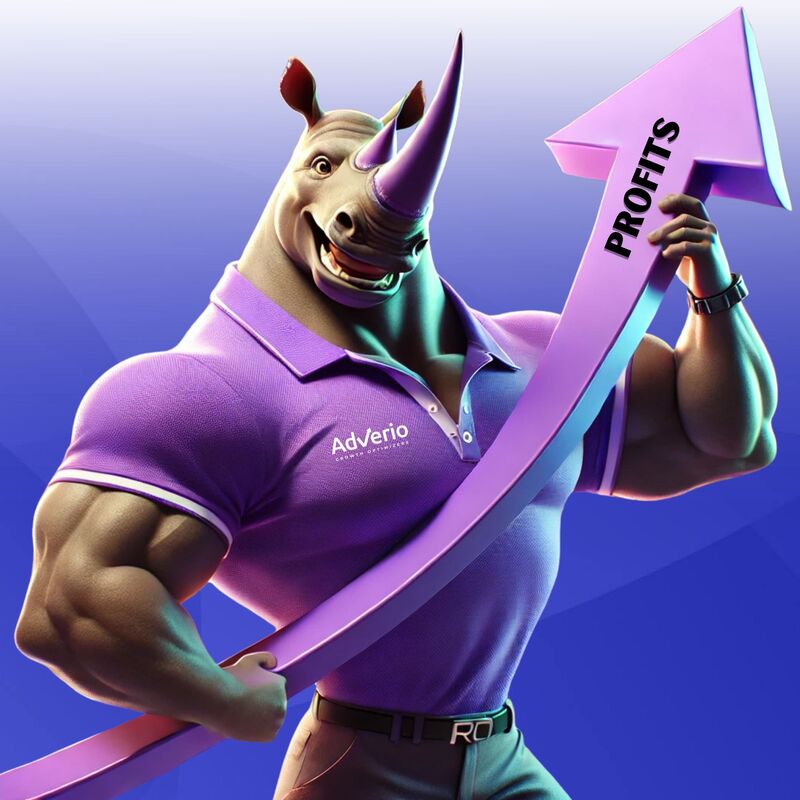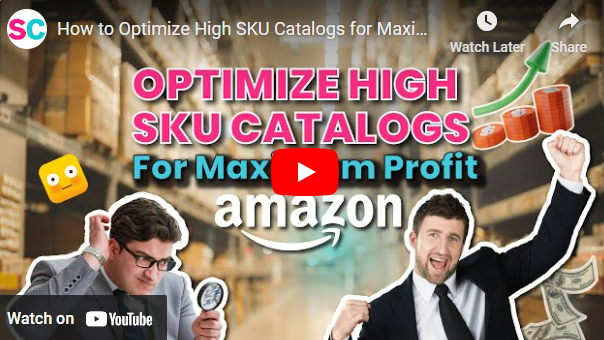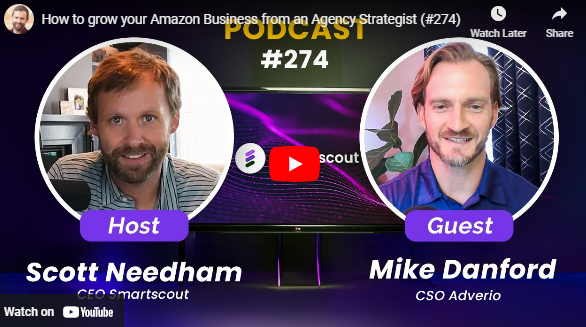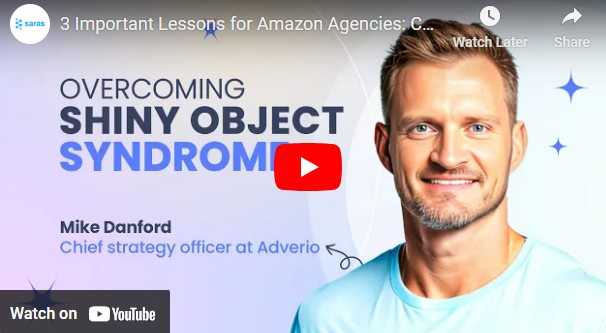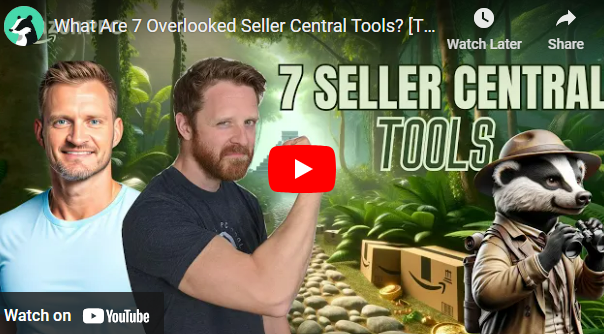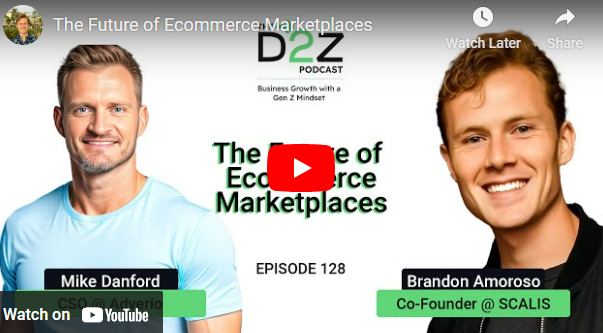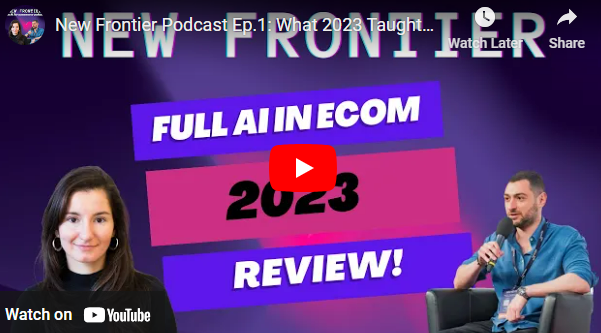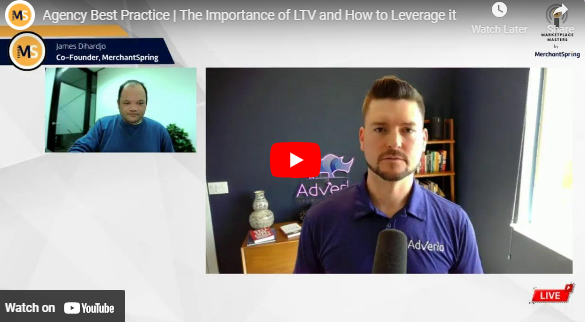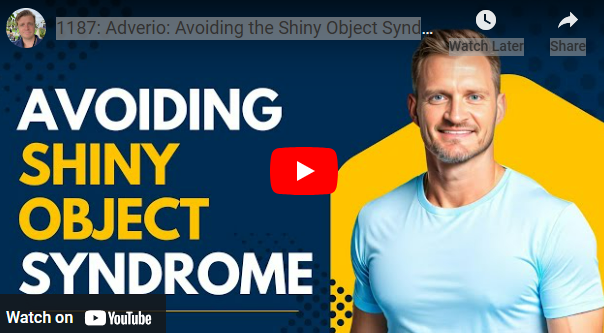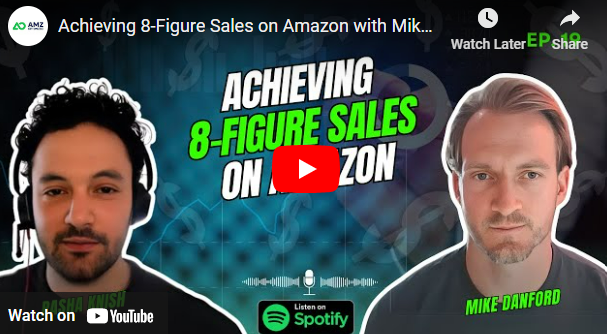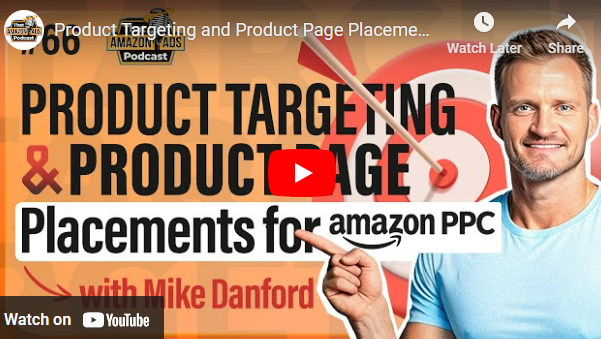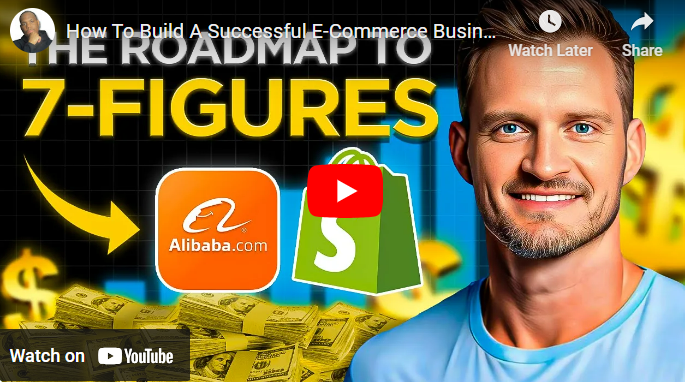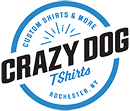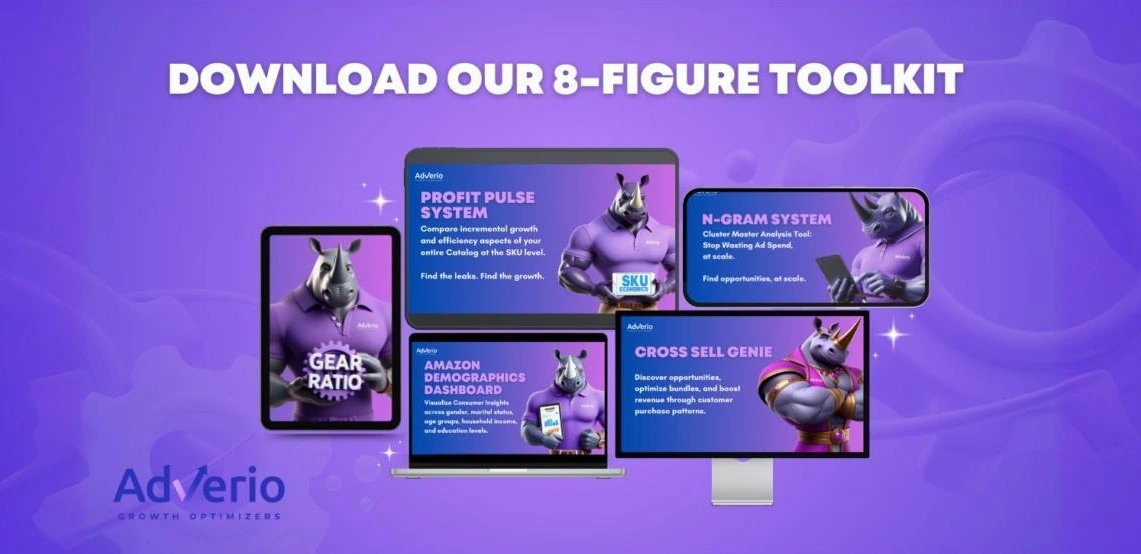The PPC Den Podcast
The world's first and longest running show all about Amazon PPC
In this episode, join Mike and Mike Danford as they dive deep into a controversial Amazon PPC strategy that many sellers overlook but could save you thousands. Are your ads failing because you’re not testing placement-specific campaigns? Let’s talk about what we uncovered.
Here’s the hard truth: most Amazon sellers waste up to 90% of their ad spend on clicks that don’t convert. Shocking, right? But it doesn’t have to be this way. In this episode, we break down why duplicating campaigns and focusing on specific placements like product pages or search results can revolutionize your PPC strategy.
Mike Danford, a seasoned pro from Adverio, shares how his team achieved single-digit ACOS by splitting campaigns into two distinct groups—one optimized for top-of-search results, the other laser-focused on product page placements. Curious about how this works?
- 0:00 – Intro
- 03:20 – Challenges with Amazon placement settings
- 04:16 – Understanding placements and bid modifiers
- 06:50 – Amazon’s intention behind placement options
- 08:12 – Base bid importance for auction visibility
- 09:45 – CPC differences across categories
- 11:51 – Testing and adapting strategies for PPC success
- 12:40 – Amazon reps specializing by category
- 13:13 – Duplicating campaigns for placement focus
- 18:02 – Negative ASINs affecting search terms
- 21:20 – Structuring campaigns by placements
- 23:33 – Placement-specific adjustments improving control
- 26:08 – Auto campaigns benefiting from segmentation
- 28:35 – Top of search vs. product page focus
- 29:44 – Success of the strategy during Prime Day
- 30:40 – Stable periods for effective testing
[00:00:00] Michael Facchin: What’s going on badger nation? Welcome to the PPC Denon podcast, the world’s first and longest running show all about Amazon advertising to make your Amazon PPC life a little bit easier and a little bit more profitable. We’ve been podcasting now for over 350 episodes. So if you want to get a checklist of a lot of our topics organized, categorized in a nice Google sheet for you so you can find what you’re looking for, when you’re looking for no matter what stage of the Amazon PPC game you are in, please check the description for a checklist that we build and maintain regularly.
Today on the show, we have friend of the show, Mike from Adverio. We’re going to be talking about placements, top of search, rest of search, product page, something that’s still even today is a little tricky to wrangle for so many. We’re going to be talking about what it might look like to have one campaign where you bid aggressively for top of search and the exact same campaign in another.
We put a little bit more aggressively for product pages. It might get some experimentation, uh, and we give you a nice little action item towards the end here about testing this in an auto campaign. So I hope you dig in. I hope you expand your skills with auto targeting. Let’s jump in.
[00:01:04] Mike Danford: I’ve launched campaigns and picked keywords.
I’ve got my bids, set placements too. Now bad mistakes, I’ve made a few. I’ve had my share of rocky ones, but I’ve come through. Me, other people, students, my friends. And we’ll keep on dancing till the end. And we’ll keep on dancing till the end.
[00:02:14] Michael Facchin: What’s going on, Mike from Adveria. Welcome back to the PBC Den podcast. Great to have you. Thanks so much for having me. Looking forward to diving in. You know, it’s, I’m a big time runner and I know that there are runners. That also do a lot of other exercising. And recently you got into hybrid training.
What is this and how has it impacted your Amazon performance?
[00:02:40] Mike Danford (2): Amazon performance. Interesting. Uh, so hybrid athlete is, you know, basically an event or competition where if you’re a runner, you’re not going to be able to complete or excel at all the events. Um, and if you are a strong man or a woman, you know, power, literature, et cetera, then you’re, you’re not going to be able to excel at the running portions of it.
So you have to be a hybrid, you have to be able to somewhat relatively strong for your body weight. Cardio. Nobody likes it. Uh, so that is huge. Um, you know, I’ve, I’ve been pretty active since really grade school, middle school specifically, and, you know, power, bodybuilding. Powerlifting. I’ve been in CrossFit since 2017, almost 2018.
And then this is a total new thing for me. Now I do Zone 2 training. I had, I’ve never done that before. It was always go, go, go. Oh, it’s so boring. Zone 2. Yes, it seems boring. But then when I realized what that does for your fat burn. Wow. I wish I had done that years ago. Um, so it’s been a fun journey for sure.
And I’m not really sure how it applies directly to, to my Amazon experience. Other than, you know, always looking for that additional optimization and hack and how to get more out of. What I’m doing,
[00:03:47] Michael Facchin: you know what I agree with that exactly. So it’s like, if you’re the mindset, you’re an optimizer, I think it carries over to the rest of your life.
Truthfully, I would also say too, like the healthier your body is. I mean, let’s get real. Like all of us listening to the show are sitting behind a keyboard for a big chunk of the day. Right? So if your body is just wrecked. outside of keyboard work. Like imagine like you don’t take care of yourself and then you sit at a computer for a big chunk of the day.
It’s like easy to feel depleted. So actually I do feel like a little bit of endurance and like could be able to push through the slog of a workout. Makes it actually, I feel like that does apply to business, digital marketing, PPC optimization, uh, I’ll stand by this. I actually think exercise is the one non business thing that you can do that makes your business life, uh, much easier.
[00:04:40] Mike Danford (2): 100%. I, I couldn’t, I couldn’t imagine just sitting at the desk and not doing everything else I do. You know, now we have, I have a sauna at the house. We have the ice plunge. I do that every morning as well. You know, you mentioned earlier coffee, like how much, can I get enough coffee today? And I’m like, I like this, the ice plunge instead.
So, yeah,
[00:04:57] Michael Facchin: so today we’re going to be touching on a really interesting topic. And I think this is a topic still not yet fully understood by most people only because it is the nature of the beast that Amazon does make it a little bit tricky to fully pin down. Placements and how they operate in sponsored products campaigns and not only that but there’s a degree of Doesn’t make sense.
Like there’s a degree of like logic failures that come into placement settings. And we’re going to be talking about this today because you mentioned something really interesting, which is taking sponsor product campaigns and then duplicating them targeting specific placements, either product pages or.
Searches, top of search, rest of search. So we’re gonna be digging into this, like what your experience has been, what made you want to get into it, what the results have been, how to actually set these up. But I wanted to start with the basics, because even today, you know, 2024, 2025, placements are still a tricky thing.
You know, I get questions, Hey, if I launch a new campaign, should I automatically give it a 50 percent top of search and touch nothing else? Or, you know, all of those things. So let’s start with some basics. We’re talking about sponsored product campaigns. What are placements? So when we call them placement or bid adjustments or bid modifiers or so on and so forth, what are these things and what’s the intention from Amazon for them?
[00:06:22] Mike Danford (2): Yeah, so it’s different types of campaign targeting. So it’s sponsored products, brands, display, DSP, on Amazon, off Amazon, etc. And this is more about where can you, um, where does this version of the ad show up? And different placements have different impacts, different visibility, etc. And you want to optimize based on that.
And certain campaign types will allow you to do that by adjusting the bid potential, if you will, for a different placement.
[00:06:50] Michael Facchin: It makes sense that if there is a placement at the very beginning of the search results versus on page two at the bottom, you would imagine that the conversion rates can be different for these things.
The competitiveness for these placements, the price that you will pay will be different for these placements. So where a piece of ad shows up on Amazon is really indicative of the overall, what the results will be. Generally, some general trends are, you know, top of search is going to be more expensive, probably convert better, matter more to organic ranking, higher levels of performance, potentially more competitive.
And then. Down deep, uh, on the rest of search, it might be a little bit softer competition. You might be paying a little less conversion rates might be a little lower, and I also want to throw a, you know, I also want to mix that up too. is there’s so many factors on Amazon. I’ve seen scenarios for whatever reason.
Sometimes that’s flipped. Sometimes certain products might behave differently in one category versus another category. Uh, and then you multiply that by the product pricing, you know, all these different factors can come together. The point is performance can be different. At these different placements, and it’s important to look at them and understand what they do.
Now the, what would you say the intention for Amazon is, like why did Amazon create these? Because at one point in time there were no placements, then there are placements. And when I say placements, I mean placement data, placement bid modifiers, where you can basically bid more aggressively for a particular placement.
Notoriously Amazon does not allow decreased bids for some funny reason. I can’t imagine why, but, um, what would you say the intention of, of Amazon having these and reporting on these is?
[00:08:49] Mike Danford (2): I think that, you know, In the early days, when they were trying to understand where they made more money, Amazon could make more money, they started realizing top of search, there was a big delta in different placements, top of search, rest of search, uh, you know, banner ads, uh, different placements on, on their own properties, etc.
So if they’re running analytics for these, They’re like, Hey, I bet if we share these performance metrics and people want to have another way of optimizing their ads, then they’ll pay more for these or less for these and see what happens. Uh, that would be my, my take on it for sure is how it began.
[00:09:25] Michael Facchin: Big time.
And again, notoriously, you can’t bid down on these things. You can’t say, let me decrease my bid on product pages by 40%. And you also mentioned you, you use very specific language when you were describing. Placement modifiers, which was what was the word that you used intend to bid or what is it exactly you say?
Oh, that’s that’s a good question trying to think I I can’t remember the exact word. So basically it’s a bid modifier up, right? So if I go into a keyword bid and I set that to be a dollar and then I go in and I set a top Of search to be a hundred percent increase. I’ve generally found that you cannot You, basically what that means is 1 keyword bid, 100 percent top of search boost, that will end up being a 2 effective bid.
And what I’ve generally found, I’m curious if you’ve found this too, that your base keyword bid matters a lot, meaning you can’t simply have a 10 cent bid and then like a 900 percent increase to get it like a, a dollar effective bid, meaning Amazon does appear. to look at that keyword level bid to assess if you’re worthy of the auction itself.
Have you noticed that as well?
[00:10:39] Mike Danford (2): Actually, that’s a great question. So we have, um, several brands and I’ll go with the betting branch because it’s the easiest to go in. Higher AOV, so 100 to 150 for the, the comforters, whatever it may be. Ironically, most of our bids that we have for those are anywhere between like 5 and 10 cents base.
And then we have pretty high relative placements to that. Two things I think that come into that is what is the typical CPC, um, for that particular category and product. I think that’s a relative part of it because we’ll have another brand that’s, you know, it’s a 15 product, so one tenth of the AOV.
However, the CPCs are like Six times that of what the, the AOV, the higher AOV products are. Explain that. It’s wild. The biggest thing is the conversion. Uh, so it’s like scrolliness for a particular category. You know, give, give an example. Embedding, it’s very common for people to click around, look at different designs, styles, densities, fabrics, comforter versus quilt versus duvet, etc.
So there’s a lot of clicks, so the cheaps need to be quicker. And apparel specific, you know, we are very specific or the apparel products that we have are very specific and they’re, they’re, the search intent is much higher once you get into those search, um, terms. So the click, the amount of clicks to a purchase is much lower so you can pay a higher, um, cost per click.
So I think that kind of plays into it. But again, I think it’s relative CPCs to your point. If we had a very low bid of say 10 cents on that. You know, a category where it’s a 1. 50 average. Then I don’t think that we would get that visibility. But one, it’d be hard to get that, that high enough of an actual click, um, being that base bid being so low, but I think it’s, I think it’s relative to.
CPCs and category
[00:12:21] Michael Facchin: big time. And I think that’s so true with everything, which is why it’s really difficult to have these hard and fast rules, which is like, always do it this way, never do it that way. This is the absolute best way. Cause it really does depend on the conversion rate of the category, the pricing of the product relative to its peers.
Um, it depends on so many things. And I think that a good. Amazon advertiser is aware of that, you know, they hear things, you know, stuff that we talk about on the show. And it’s really important to test, uh, in isolation test in sort of, you know, test certain products or certain campaigns a particular way, and then see how it behaves for your product in your Uh, industry.
So I think that’s such a vital skill to have, um, because if there truly was a one best way for every single scenario, there wouldn’t be agencies, there wouldn’t be any confusion with how to do it. You would just turn it on and it would be that way. But, um, there is so much like testing, poking, prodding, which is where A lot of the work comes in.
[00:13:31] Mike Danford (2): I’m going to interject just a little bit. It’s a great thing that you mentioned that. So that’s why we, we double down in soft lines and larger catalogs and in certain verticals that we already know, um, and have that experience as opposed to dipping into something where we may have less to experience, certain type of TPG or.
Whatever it may be, but we’ve learned what works at a category level and that’s what applies across multiple brands. It’s, it’s been great for us.
[00:13:53] Michael Facchin: Truly. I mean, even Amazon does it with their own reps. Like you can, you talk to a rep, oftentimes they’ll be in a particular category so they can gain some skills there.
[00:14:04] Mike Danford (2): Let’s say Walmart gets one of that. I mean, they had the category specialist, but we, we are often teaching them what works and doesn’t work in the categories.
[00:14:12] Michael Facchin: Oh boy. Now that we’re sort of aware of what placements are. I want to. touch on this idea that you had where you basically take a campaign and you duplicate it and then you focus in on certain placements.
First of all, how did you come up with that idea? And what does it look like when in practice?
[00:14:31] Mike Danford (2): Yeah, absolutely. So we’re, we’re really big fans on negation and heavy negation and going to a more, you know, general or reach, um, targeting say broad auto phrase, et cetera, as opposed to an exact. Can you pause
[00:14:44] Michael Facchin: there?
Cause that’s really interesting. Uh, Just to clarify, you mentioned that you like broad type targeting and then you are heavy into negating. Number one, I did an analysis earlier in the year of really high performing accounts that’s, you know, spending a lot and with a very low A cost. And those are the characteristics that I found time and time again.
Uh, heavy, heavy negative keyword multiple, meaning like they had many, many more times negative keywords and negative targeting than they did positive targeting. Um, you know, oftentimes it’d be like 20 times more. So they had 2000 keywords. They might have 40, 000 negatives. So like an intense amount of negatives.
That’s what, is that what you’re saying? And. Yeah, absolutely. Can you elaborate a little bit on that?
[00:15:29] Mike Danford (2): Yeah, yeah, we’ve actually developed a metric specific for that. Um, we have correlation factors to it to understand, but you know, in general, we, for a lot of, again, the categories we have, we have large catalogs, so we have a lot of products that are kind of competing for the same placements on search, off Amazon, product detail pages, wherever it may be.
Um, so we have to be very strategic for that. And the clicks. Uh, or much cheaper on say a category target or expanded ASIN target or abroad, or even an auto, we still lean heavy into autos, uh, which seems so, so anti, but anyways, with that, you have to be extremely diligent and more vigilant with your neg, negation.
So, you know, I don’t know, a year ago, maybe I would have never said I could, I would have negated a term with only four or five clicks in, in maybe a 30 or 60 day timeframe. Um, but for us with this, you know, larger reach targeting, we’re okay to do that because it, we have thousands of other search terms that we’re converting on, so we don’t need to go for that.
And we still want the search terms that we are converting on to get those really cheap clicks, because we get the same click through rate and conversion rate just that cheaper if we can figure out how to optimize for those more, um, broad, expanded, uh, targetings. Beautiful.
[00:16:38] Michael Facchin: Well said. Anyway, back to my initial question, which was, where did you come up with the idea for placement specific campaigns, duplicating a campaign and then having it focus on a certain type of placement?
[00:16:50] Mike Danford (2): Yeah, I think you have it. It’s called the ACOS power ratio. I believe it’s your metric that you have. We have one that’s very similar. In house that we go with, but we were looking at it and we got gear, growth, efficiency, um, advertising ratio, and there’s some weight tool with incrementality, but long story short, there is holy cow, like 85 to 95 percent of some brands spin is going to clicks with not that are not converting yet.
We still have 3, 000, 5, 000, 10, 000 converting search terms every single month. So we were like, Hey, why don’t we just do a full stop switch and go all exact on these terms because we have 100, 000 search terms that we’re getting each month and only, you know, about 5 percent of them are converting. Yeah.
Why not go after those? Well, that doesn’t work. We kind of knew that, but the brand wanted to, you know, Hey, we do have to answer to the brand. We do have to explain why we spend a 90 percent of our spend, which is, you know, a hundred to a thousand a dollar each month on terms that aren’t converting. So we were able to answer that.
Long story short, that resulted in CPCs going through the roof, missing out on tons of different things. Isn’t that,
[00:17:54] Michael Facchin: I think that’s one of the most annoying things in all of. PPC that you, why can’t you just do that? Like imagine you just, you imagine you just went to your account and you said, show me all search terms with one order in the last 60 days and just turned everything else off.
That’s another strange quirk about the way Amazon works.
[00:18:11] Mike Danford (2): Yeah, absolutely. So anyway, so doing that and confirming with the brand in their own money, with their own dollars and let them know like this doesn’t work. And there’s parts of it does work. So don’t, don’t get me wrong. Some of it does work and we can do different things.
Not saying don’t do exact maths by amings. Um, use all the math types. Went back to that. So when we go back to the broad and automatic campaigns, we’re going in and we’re like, okay, so why don’t we be more aggressive on our negation? So we have our thresholds at whatever formulas we have. Tons of different ways of doing it, depending on relevancy, clicks, conversions, whatever it may be.
Like, okay, why don’t we just get rid of Everything that doesn’t convert, but keep the 5, 000 or so search terms active and, you know, hopefully trigger in the broads, categories, et cetera. Well, one thing that really impacted that is when you negate and realize when we negated ASINs at least in bulk, we actually stopped showing up for search terms in certain campaigns.
Uh, and that was the quickest thing that we, we noticed. And product detail page placements dropped. The, the conversion and traffic impressions on those placements dropped. Overnight, and it was very instant, clear. We did it at scale, and we want to do it at scale so we can understand quickly what’s happening.
So we reverse that, and then we dig in and kind of find out when you have a campaign that is going after ASINs or triggering for ASINs, etc. And you want to negate it just because that product detail page for that ASIN doesn’t convert well. We found that you also block the search terms that that ASIN also triggers for in that campaign.
If you do it, there’s gotta be a way where you’re negating enough ASINs, enough times that are blocking the same keywords that it says, okay, you don’t wanna show up for these keywords in this campaign, so it blocks that, that keyword. That’s the theory that we have on it. I don’t want to keep going into what we did, but that’s, that’s what started all this.
[00:19:53] Michael Facchin: Hey y’all, it’s Mike here. I hope you’re enjoying this episode. I know that I am. One thing that Mike mentioned is the amount of non converting spend in an account. In quarter four 2024, we actually rolled out a non converting spend dashboard where you can actually track for any PPC account the amount of non converting spend over time so that you can see how your ACoS changes.
it, when you expand, when you spend more as in relation to your non converting spend. It’s one of my favorite new tools that we’ve released. It’s one of the things that excite me the most to build tools that allow advertisers to advocate for themselves and sort of claw back some of that ad spend so that they can dedicate it towards spend that actually does convert.
I always try to say you don’t have an a cost. Too high because of the things that do convert. You have an A cost that’s too high because of the clicks that don’t convert. Anyway, check it out. Let’s get back to the episode. So you notice a high amount of non-con converting spend. You go in and you flick on only exact matches.
CBCs go through the roof, and then you. When you backtracked, you began to notice something interesting about adding negative ASINs and how that impacts search terms. So I just want to call out a quick point here. Uh, for, on Amazon PPC, you can target ASINs. And then see search terms in your search term report, and vice versa.
This is a strange thing on Amazon. I’ve never heard a good explanation from Amazon on it. Sort of like the general understanding that you just mentioned, but break that, break that down again for people who might not be aware that this is happening.
[00:21:29] Mike Danford (2): Sure, I think Amazon, you know, some brands may not even know how to use an ASIN or a category or a product detail page targeting or placement, etc.
If you have search terms that you’re going over, Amazon’s going to say, Hey, there are products that are relevant to your search terms. And we think that you will convert for it. So we will also want to give you a placement visibility on that. Asyn and that products detail page. And yeah, you’re not targeting that Asyn, but we think that you should.
So we’re going to force you to, right? Disability, which is a good thing. We like that they they’re creating things, but we also have to take some of that control back.
[00:22:04] Michael Facchin: Yeah. So you notice that this is happening, of course, that I’m targeting keywords. I’m showing up on product pages, which convert differently than keywords, right?
Like, so these things convert differently and that inspires you to say, Hey, what if we had a campaign focus just on search? And then another one focused on product pages. So how did you architect that? Like, are you literally just copying a campaign, same, same keywords, and, you know, one gets a higher product page bid, the other gets a higher type of search bid?
Talk, talk me through the actual structural mechanics of what you did.
[00:22:39] Mike Danford (2): Yeah, let’s take one step back to clarify that we, you have keyword targets and you also have ASIN targets. And both of those have Product detail page placements, or SERP, or Topic Certified Research Result, um, placements. Correct. Just to clarify that.
With that, we, again, when you were having, uh, either, it could be an automatic, it could be a, a keyword, it could be an ASIN targeting campaign. If you negate an ASIN in those campaigns, and some of them are ad group level, some of them are at the campaign level, depending on what you can do. You’re going to block search results.
Well, we don’t, we don’t want to do that. We, we only wanted to block that particular ASIN’s product detail page because it didn’t convert at the level of whatever statistics or metrics we wanted. So, how do we prevent that from happening? You just mirror the, the campaign. It can be the, the same exact auto.
It could be the same exact keyword campaign. It could be the same exact category, ASIN campaign, whatever it may be. And you have to set the base bid, to your point earlier, low enough. That it doesn’t show up on one of the search results or the pre product detail page. And then the inverse of that is you’re going to push, um, if it’s a search results campaign, you want to do, you’re going to have a really high top of search, probably about half of that on the rest of search, and you’re not going to have a placement multiplier on your product detail page.
In theory, once you get that figured out where your base bid is low enough, you’re not going to have any, um, shouldn’t have any ASINs or product detail page placements in that campaign. And then you’re going to do the exact opposite on another campaign that’s identical with the targetings. The only difference is your placements are inverted, so you’re not going to have any placement multipliers for top of search or rest of search, but you’re going to have a high product detail page or product placement multiplier.
Your base bids are usually going to be pretty consistent and close in the campaigns, at least when you start. But as we talked about earlier, uh, detail page, CPCs, conversion rate, click through rate, et cetera, is much different than it is on a search on a result page. And this gives us two things. One, it’s very clean in the campaign, in the campaign manager if that’s what you’re using.
If you’re using third party tools, it helps with bundling and And grouping things together so you can see performance over time. And then there’s other ways as well to kind of optimize by placement. It gives you another level to pull without knowing that you’re, you’re overly negating or overly blocking some other, um, placement.
[00:24:56] Michael Facchin: How do you ensure that things don’t eventually converge, right? Like, meaning, if you’re optimizing for performance, what does the team have to keep in mind so that they don’t accidentally change bids in a way that It basically undoes what you intended to do.
[00:25:13] Mike Danford (2): Yeah, that’s a great question. So we have it built in where if it’s a SERP campaign, then we don’t want to have, you know, zero is the hard set on the product detail page multiplier, and it can never be greater than zero.
So that’s one thing. And the other is, you’re more constantly optimizing the placements than you are the bid. Because when you move the bid, and also you don’t want to have the bid to be above a certain number. So we know what the average CPC is for a brand. Or a campaign or where it may be. And you’ll say, Hey, this is the threshold.
It’s usually half of whatever the average CPC is. And that kind of keeps it again, where you can move that base bit up and down without eventually, like you said. Commingling and going back into a different placement. You didn’t want to, and there’s also a reset. So every month there’s a reset, make sure we didn’t do it.
You’re still gonna have, I mean, even as vigilant and, and diligent as we are in, in those parameters, we still have random product placements and a cert campaign and vice versa. But it’s a very small percentage. And then obviously the ACOs is, you know, single digits for that stuff. But it’s just not a, you know, it’s not moving the needle.
I’m curious to, so you’re
[00:26:16] Michael Facchin: doing this primarily on sponsored products, is that right? Correct. And when you evaluate. The like search term or well, I guess my first question is actually in what percentage of your campaigns are you doing this? Have you noticed areas where it works better and areas where it doesn’t work as well?
[00:26:37] Mike Danford (2): Oh, it’s great question. I would say that where we see the bigger impact is going to be an automatic campaign. and category campaigns. When you get into the more specific keyword versus, um, ASIN or expanded PAT uh, campaign targeting, it gets a little different. But when you get to those, those, if you do that, if I were to say, if you want to start somewhere, it’s those.
If you still, if you’re not running automatics, I want you to go back and run automatics and figure this out. Like, oh, we just talked about negation, et cetera. That’s where we see the biggest, um, efficiency created through this strategy.
[00:27:13] Michael Facchin: Awesome. So, There’s one action item worth experimenting with, it’ll be to essentially duplicate, you know, I’ve done a lot of testing over the years with auto campaigns, whether it be single auto target in a, you know, so like one product for campaigns, each individual auto target, or, you know, one product The first one compliments and, uh, substitutes the next one close and loose.
So, like, two separate campaigns just with, with split targeting like that. And I’ve generally found that that does work well. Uh, we did it with a, we had an episode maybe two years ago where we did that at scale and that worked really nicely. My general rule of thumb is, like, more segmentation is typically better unless it becomes so unmanageable that you end up You know, losing your breadcrumbs or not understanding what to do and how to optimize.
So I would say in general, it’s, it’s worth segmenting until it becomes a burden or the algorithm doesn’t agree with you. So the action item that I think is really interesting here is if you have a auto campaign. And, do you do this with all four targets turned on?
[00:28:21] Mike Danford (2): Yeah, so, interesting what you just mentioned.
So we did that probably about the same time, one or two years ago, where we split, you know, uh, subs, comps, closed sloots, and, and had mirror campaigns and broke them out. During all of this, we tested it, we went back, now, the two, both versions of the campaign have all four of those active now, and because we We don’t care how it shows up on a pod detail page or a cert.
We just want to do it. And this segmentation, I think, gives us better control over it as opposed to that. But we did that. And to your point, that worked better than not doing that. So that was for sure you mentioned. Yeah.
[00:28:52] Michael Facchin: So one auto campaign, all four targets turned on, you go and then you do exactly what you just described where you go and you give one campaign the top of search boost.
And you said like the rest of search, you would do half of that. So like the, you know, you use the word SERP stands for search engine result page. You have one focused on the SERP, another focused on product pages, and that one gets the product page. And then the Z, the inverse is zero. So like you’re on your search ones, product page will be zero on your product page.
One type of search versus search will be zero. And that’s awesome. That’s, that’s something for the good people out there in Badger Nation to test with. I think we, I always like to give people something to do and like, I think that’s their homework for this episode. I encourage people to test this out. In general, I love these kinds of experiments where you take something and you play with the settings, you see how the algorithm reacts.
And it is frustrating that, number one, you can’t downbid. Because I wonder what this strategy would look like if you could just go in and you could downbid in some places. Uh, as opposed to zero being the lowest number. Um, so that’s a little frustrating. But in general, yeah, this is, this is, this is cool.
Closing thoughts on this, like, how long have you been doing this as well? I’m always curious by the longevity of this so far.
[00:30:07] Mike Danford (2): Yeah, at scale, this happened around Prime Day. We did the heavy negation prior to Prime Day because we were like, Hey, we don’t want to Uh, spin is going to scale 5X for a lot of these brands for that, that event.
So it can we even take a dent out of that, you know, non converting spin? What would it look like? I’m so glad we tested it a couple of weeks prior and had time to turn it back on. So I guess what about six months, little over five months here, it’s kind of where we’re at and we, we’re applying this to every brand that we work with, every brand that we audit, um, Hey, if you’re not doing it, if you don’t want to work, if you don’t end up working with us or, you know, we’re not a good fit just because of whatever, whatever reason do it.
And we have had comments where like, Oh, wow, that, that alone gave us a boost that we were looking for because they’re not testing other things. So that’s another thing is when you do this, try your best to give it a couple of weeks and not do much other volatile updates or optimizations and see what happens.
I would wait until after, after the holiday because the 18th here in about, well, I’m not sure when it’s a release, but don’t do it around tentpole because it will not give you the best results. You don’t want to wait until you have a little, um, stable time.
[00:31:11] Michael Facchin: Normalcy, yeah. Well, thank you so much, Mike. If someone wanted to get in touch with you, what’s the best place for them to get in touch with you?
[00:31:17] Mike Danford (2): Sure, uh, at vario. io. So that’s A D V E R I O dot I O. I will see if we can spin up a webpage where you can submit your results from this, this test. Uh, so hopefully we can give you a link. update on that, Mike, for the, when he released the podcast until we can get some, some, some good case studies. Right on.
Uh,
[00:31:37] Michael Facchin: well, thank you so much, Mike. Uh, have a good one and everyone else. I’ll see you here on the BBC 10 podcast.

